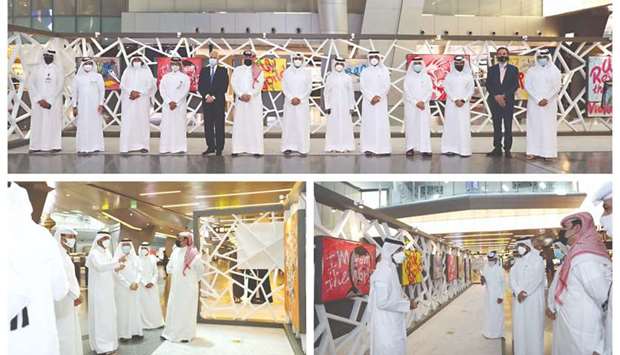The National Human Rights Committee (NHRC) has organised an Arabic calligraphy exhibition on Human Rights in the Islamic Culture for artist Sabah Al Arbili, and the Human Rights exhibition for artist Ahmed Al Maadeed, at Hamad International Airport, in the framework of the activities of "Doha Capital of Culture in the Islamic World".
The "Doha Capital of Culture in the Islamic World 2021" is organised under the supervision of the Ministry of Culture and Sports, in co-operation with the Islamic World Educational, Scientific and Cultural Organisation (ISESCO), the Qatar National Commission for Education, Culture and Science, and the strategic partners in the Qatar government and partner bodies.
NHRC Secretary-General Maryam Abdullah al-Attiyah said in a press release yesterday that the NHRC permanent exhibition on *Human Rights in Islamic Culture is considered one of the most distinguished activities implemented by the committee at the local, regional, and international levels.
The exhibition shows to the world that Islam had adopted the principles of human rights 1400 years ago, and that the way to address the extremism and terrorism that certain parties are trying to attach to Islam is always by building bridges of co-operation and dialogue between different religions, cultures and civilisations, and the search for heritage and common human values, and not through the growing rhetoric of intolerance and hate, she added.
Al-Attiyah explained that the *Human Rights exhibition contains paintings bearing messages related to rejecting hate speech, opposing violence and rejecting it in all its forms, and spreading the message of peace in all parts of the world, and highlights the importance of human being and his positive influence in the society.
For his part "Doha Capital of Culture in the Islamic World" general co-ordinator Hamad al-Adhba said that Arabic calligraphy is one of the most important arts created by the Arab and Islamic civilisations, and the most widespread in Arab and Muslim countries.
He added that Arabs and Muslims, regardless of their schools, were able to make Arabic calligraphy a tool for aesthetic expression of the Holy Qur'an, the Sunnah of the Prophet (peace be upon him), and the eternal Arab wisdom, which gave it a special luster that increases its beauty.
Al-Adhba stressed the importance of investing in the activities of “the Capital of Culture in the Islamic World” to push this original art to the facade, by raising awareness of its value and aesthetics, supporting young talents in this field, and holding exhibitions, lectures and courses that promote Arabic calligraphy.
NHRC Secretary-General Maryam Abdullah al-Attiyah said in a press release yesterday that the NHRC permanent exhibition on *Human Rights in Islamic Culture is considered one of the most distinguished activities implemented by the committee at the local, regional, and international levels.
The exhibition shows to the world that Islam had adopted the principles of human rights 1400 years ago, and that the way to address the extremism and terrorism that certain parties are trying to attach to Islam is always by building bridges of co-operation and dialogue between different religions, cultures and civilisations, and the search for heritage and common human values, and not through the growing rhetoric of intolerance and hate, she added.
Al-Attiyah explained that the *Human Rights exhibition contains paintings bearing messages related to rejecting hate speech, opposing violence and rejecting it in all its forms, and spreading the message of peace in all parts of the world, and highlights the importance of human being and his positive influence in the society.
For his part "Doha Capital of Culture in the Islamic World" general co-ordinator Hamad al-Adhba said that Arabic calligraphy is one of the most important arts created by the Arab and Islamic civilisations, and the most widespread in Arab and Muslim countries.
He added that Arabs and Muslims, regardless of their schools, were able to make Arabic calligraphy a tool for aesthetic expression of the Holy Qur'an, the Sunnah of the Prophet (peace be upon him), and the eternal Arab wisdom, which gave it a special luster that increases its beauty.
Al-Adhba stressed the importance of investing in the activities of “the Capital of Culture in the Islamic World” to push this original art to the facade, by raising awareness of its value and aesthetics, supporting young talents in this field, and holding exhibitions, lectures and courses that promote Arabic calligraphy.



